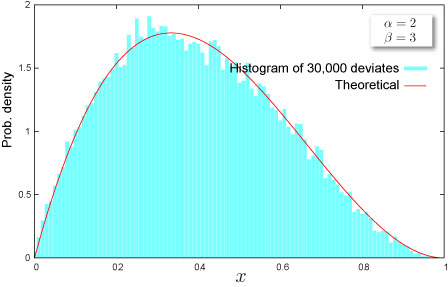Beta Distribution
Where do you meet this distribution?
- Bayesian statistics
- Project management -- PERT, CPM and so on
- Information theory
- Rule of succession
- Risk management -- Operational risk
Shape of Distribution
Basic Properties
-
Two parameters are required (How can you get these?)
-
Continuous distribution defined on bounded range
-
This distribution can be symmetric or asymmetric.
Probability
-
Cumulative distribution function
where is regularized incomplete beta function.
-
where is beta function.
-
When the 4th. argument of NTBETADIST=TRUE, this function returns same result as Excel function "BETADIST" does.
-
How to compute these on Excel.
| A | B | |
|---|---|---|
| 1 | Data | Description |
| 2 | 0.5 | Value for which you want the distribution |
| 3 | 8 | Value of parameter Alpha |
| 4 | 2 | Value of parameter Beta |
| 5 | Formula | Description (Result) |
| 6 | =NTBETADIST(A2,A3,A4,TRUE) | Cumulative distribution function for the terms above |
| 7 | =NTBETADIST(A2,A3,A4,FALSE) | Probability density function for the terms above |

- Function reference : NTBETADIST
Quantile
- Inverse function of cumulative distribution function cannot be expressed in closed form.
- BETAINV is an excel function.
- How to compute this on Excel.
| A | B | |
|---|---|---|
| 1 | Data | Description |
| 2 | 0.7 | Probability associated with the distribution |
| 3 | 1.7 | Value of parameter Alpha |
| 4 | 0.9 | Value of parameter Beta |
| 5 | Formula | Description (Result) |
| 6 | =BETAINV(A2,A3,A4) | Inverse of the cumulative distribution function for the terms above |
Characteristics
Mean -- Where is the "center" of the distribution? (Definition)
-
Mean of the distribution is given as
-
How to compute this on Excel
| A | B | |
|---|---|---|
| 1 | Data | Description |
| 2 | 8 | Value of parameter Alpha |
| 3 | 2 | Value of parameter Beta |
| 4 | Formula | Description (Result) |
| 5 | =NTBETAMEAN(A2,A3) | Mean of the distribution for the terms above |
- Function reference : NTBETAMEAN
Standard Deviation -- How wide does the distribution spread? (Definition)
-
Variance of the distribution is given as
Standard Deviation is a positive square root of Variance.
-
How to compute this on Excel
| A | B | |
|---|---|---|
| 1 | Data | Description |
| 2 | 8 | Value of parameter Alpha |
| 3 | 2 | Value of parameter Beta |
| 4 | Formula | Description (Result) |
| 5 | =NTBETASTDEV(A2,A3) | Standard deviation of the distribution for the terms above |
- Function reference : NTBETASTDEV
Skewness -- Which side is the distribution distorted into? (Definition)
-
Skewness of the distribution is given as
-
How to compute this on Excel
| A | B | |
|---|---|---|
| 1 | Data | Description |
| 2 | 8 | Value of parameter Alpha |
| 3 | 2 | Value of parameter Beta |
| 4 | Formula | Description (Result) |
| 5 | =NTBETASKEW(A2,A3) | Skewness of the distribution for the terms above |
- Function reference : NTBETASKEW
Kurtosis -- Sharp or Dull, consequently Fat Tail or Thin Tail (Definition)
-
Kurtosis of the distribution is given as
-
This distribution can be leptokurtic or platykurtic.
-
How to compute this on Excel
| A | B | |
|---|---|---|
| 1 | Data | Description |
| 2 | 8 | Value of parameter Alpha |
| 3 | 2 | Value of parameter Beta |
| 4 | Formula | Description (Result) |
| 5 | =NTBETAKURT(A2,A3) | Kurtosis of the distribution for the terms above |
- Function reference : NTBETAKURT
Random Numbers
-
The algorithm to generated random numbers is shown in:
R. C. H. Cheng, "Generating beta variates with nonintegral shape parameters", Communication of the ACM, 21(1978), pp 317-322
-
How to generate random numbers on Excel.
| A | B | |
|---|---|---|
| 1 | Data | Description |
| 2 | 0.5 | Value of parameter Alpha |
| 3 | 0.5 | Value of parameter Beta |
| 4 | Formula | Description (Result) |
| 5 | =NTRANDBETA(100,A2,A3,0) | 100 beta deviates based on Mersenne-Twister algorithm for which the parameters above |
Note The formula in the example must be entered as an array formula. After copying the example to a blank worksheet, select the range A5:A104 starting with the formula cell. Press F2, and then press CTRL+SHIFT+ENTER.
- Function reference : NTRANDBETA

NtRand Functions
- If you already have parameters of the distribution
- Generating random numbers based on Mersenne Twister algorithm: NTRANDBETA
- Computing probability : NTBETADIST
- Computing mean : NTBETAMEAN
- Computing standard deviation : NTBETASTDEV
- Computing skewness : NTBETASKEW
- Computing kurtosis : NTBETAKURT
- Computing moments above at once : NTBETAMOM
- If you know mean and standard deviation of the distribution
- Estimating parameters of the distribution:NTBETAPARAM